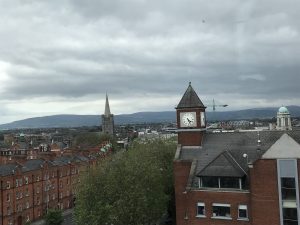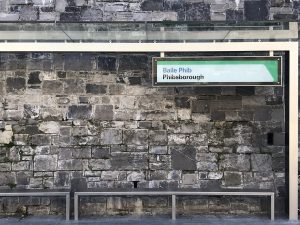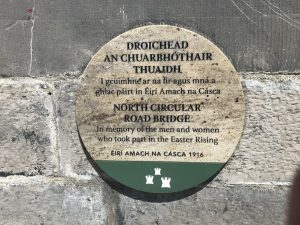
Dublin is a diverse city full of many different cultures and languages. Walking down City Centre, you are bound to hear groups of people speaking Spanish, French, Polish, Chinese, Arabic and especially English. However, oral discourse is only a small factor in determining the linguistic landscape of a country. Last year in Ireland, “tourism was worth more than €6 billion, a 10 per cent increase on the previous year” and the number of visitors entering the country climbed above 11 million. A lot of these spoken native languages can be attributed to this influx of tourism. The question then remains, is Ireland as culturally diverse as it seems to be at face value? The most common language used is clearly English. Although Irish is seen almost everywhere on state-sponsored signs, there is barely any Irish spoken in day to day conversation.
As discussed in the journal, “Commodified Language in Chinatown: A Contextualized Approach to Linguistic Landscape”, linguistic landscapes are “embedded in larger sociopolitical processes”. On my daily commute to work, I can hear the bus announce in Irish and English the next station. I often see street signs written in both Irish and English as I walk down the city of Dublin. However, I have only heard Irish spoken between people maybe once or twice. It is important to recognize that this a common narrative only in Dublin. There are many parts of Ireland I have yet to visit, which may or may not use Irish as the colloquial language. However, Dublin is the largest city and capital of Ireland, as well as the country’s economic hub. It is a direct reflection of how the existing institutions around a city can shape its linguistic landscape.

Dublin hosts many international companies from mostly English-speaking nations such as Google, Facebook, Johnson and Johnson, etc. A lot of European and American companies are willing to move to Dublin because the 12.5% corporate tax rate is the lowest in the world. In fact, many companies have already lined up to move to Dublin from the UK post Brexit. As such, Dublin is incentivized to use English in everyday life in order to bolster their economic standing. Similarly, Ireland is a part of the EU. Not only are there several trade linkages because of this political and economic union, Ireland is mandated to follow different laws and regulations. By being a part of the EU, Irish citizens are incentivized to learn English so they can travel to other EU countries looking for work or education. English is a very important part of Ireland and it will continue to be so as the country develops economically. However, the use of the Irish language as a part of a “symbolic economy” adds to its cultural importance.
When walking down Temple Bar or other touristy areas, you will notice that the Irish language is showcased more in front of bars. This specific neighborhood uses the aesthetic of pub and bar culture meant to create “distinctive urban experiences that attract tourists and residents”. In doing so, this neighborhood becomes a site of cultural consumption.

Interestingly, it is mostly public spaces or government organizations that spread Irish language in an attempt to capitalize on tourism. Another example of this would be the Guinness factory where people are charged 18 euros for a tour and “authentic” beer which you can get for 5 euros anywhere else.
When it comes to private enterprises, there is very little attempt to use Irish as a means to garner customers. When buying groceries from Lidl or Spar, there is little to none Irish product placement.
It is clear that the Irish language is used as a tool in Dublin in order to showcase its culture and authenticity. Admittedly, it is concerning that Irish is sometimes targeted towards out-groups in order to be a more attractive area. However, this situation is not the same as the one discussed in the journal. In Ireland, the language and culture is used to bolster the country itself. In DC, the minority Chinese populations, which have already been marginalized, are taken advantage of in an attempt to bolster economic standing. Irish culture and language is very much in the power of those that created it. The Chinese culture is exotified and is put on “display largely for the benefit of out-group individuals”. The socio-historical contexts are largely different, but it is still important to look at the linguistic landscapes of each country. Although Dublin can be very touristy, the local people here are very proud to be Irish. From what I have experienced, they are comfortable with their language and enjoy their culture. Moving forward, I think the preservation of the Irish culture and language will be a difficult topic for the country. With an international trend towards globalization, this notion of moving past the norm has affected several different countries. It will be very interesting to see how this country will change, especially with the current implications of Brexit.

Zishan,
I thought that your linguistic analysis of Dublin was interesting. I had no idea that Ireland had such a low corporate tax rate. I think that the dual function of Irish as both a marketable commodity and a way to preserve a historically repressed language is fascinating even though I’d never really considered it before. I wonder too how the Irish language will hold up to the increasing dominance of English on a global scale.
It’s very eye-opening to hear that English is the most common language spoken on the streets of Dublin. The use of the Irish language as a tool for commodification is also intriguing since that is, in fact, the native language, not an external one. Ireland provides a perfect example of the effects of living in a highly globalized world, so, as Elizabeth mentioned, it will be very interesting to see what the future holds for this nation.
I will actually be studying at Trinity College in Dublin in the Fall of this upcoming school year, so I really appreciate your detail in this essay. I find it interesting that there is a dichotomy between the use of Irish in advertisements and street signs and the use of Irish in everyday speaking. I would imagine that the reason Irish is used more frequently in physical manifestations of language rather than auditory manifestations is that it can be used to foster civic pride in the city of Dublin in a way that encouraging the use of the Irish language in day-to-day speaking can not.
Hi Zishan! Really interesting and well organized essay. It is interesting that you observed that while Irish is used on street signs and other public postings, it is rarely used in face to face discourse. Could this use of Irish by announcements on public transport, for instance, be a means of holding on to the nation’s history? Hope you’re having a great time.